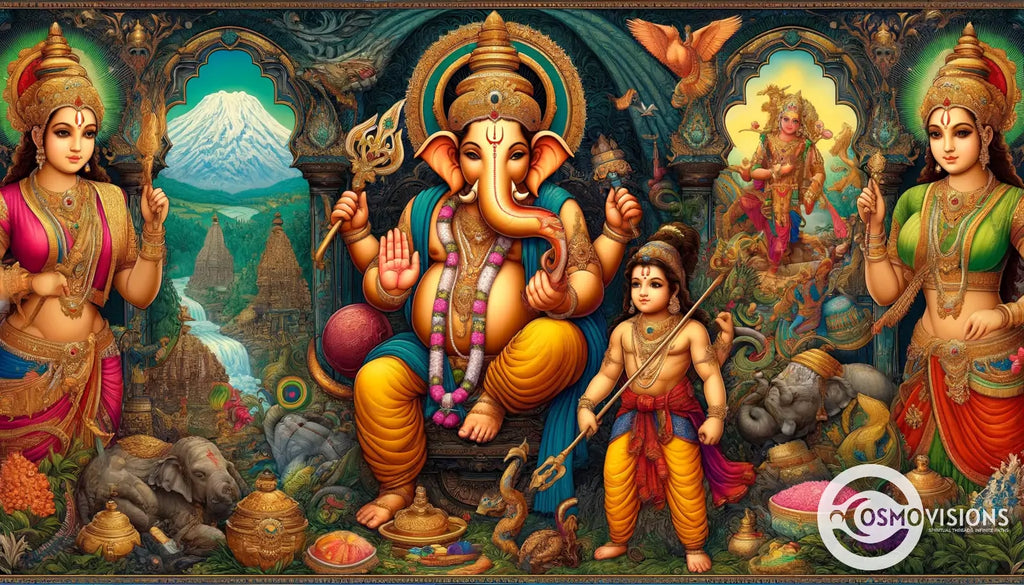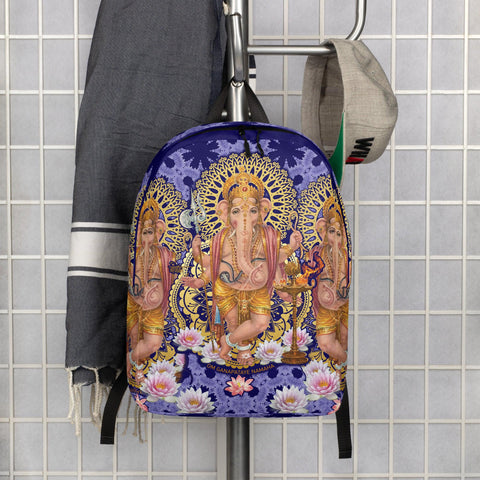Ganesh Brother: The Divine Connection Between Lord Ganesha and Kartikeya
Posted by Massimiliano Geraci

Exploring the connections between divine siblings in Hindu mythology opens a window to understanding broader spiritual teachings. One such captivating bond is that between Lord Ganesha, the remover of obstacles, and his brother Kartikeya, the hindu god of war.
This relationship highlights aspects of wisdom, power, and sibling dynamics within the pantheon. Interestingly, both deities hold significant roles in Hindu culture yet are worshipped differently across regions in India.
Our blog post examines this divine connection by uncovering how Kartikeya’s valor complements Ganesha’s intellect. From their legendary races to their distinct worship practices at temples across India, we explore how these stories and rituals foster a deeper appreciation for Indian spirituality and art forms.
Our journey through their tales enlightens us about Hinduism and enriches our understanding of familial bonds in divine settings. Discover the essence story of brotherhood among gods with us.
Who is Kartikeya, the Elder Brother of Lord Ganesha?
Kartikeya, also renowned as Murugan, called Skanda, and Subrahmanya in various regions of the Indian subcontinent, stands as a pivotal deity within Hindu pantheon. Born to Goddess Parvati and Lord Shiva on Mount Kailash, he embodies the epitome of youth, beauty, valor, and wisdom.
His tales are celebrated across South India, particularly in Tamil Nadu where he is revered not just as the god of war but also for his intelligence that vanquished powerful demons like Taraka.
As the elder brother to Lord Ganesha, Kartikeya’s stories inspire devotees with themes of bravery, sacrifice and loyalty.
His vahana or divine vehicle is a peacock named Paravani which symbolizes the destruction of ego and arrogance. Festivals like Thaipusam in Tamil Nadu and Sri Lanka glorify him through elaborate rituals that reflect deep spiritual significance.
The Six Abodes of Murugan—Arupadaiveedu—are prominent pilgrim sites dedicated to him spread across Southern India showcasing diverse aspects of his mythology through intricate iconography involving his consorts Valli and Devasena.
In this rich tapestry woven around Kartikeya within Hindu mythology shines forth an exemplar whose stories foster an understanding beyond worship; they illuminate paths towards inner strength and enlightenment.

Lord Kartikeya in Hindu Mythology
In Hindu mythology, Lord Kartikeya stands as a pivotal figure of valor and youth. Born to Shiva and Parvati, he emerges as the divine son born commander of the celestial armies, destined to defeat the asura Tarakasur.
His birth story encapsulates the complexities of divine intervention and necessity for balance between good and evil within the cosmos. Known by various names such as Murugan, Skanda, and Subramanya across different cultures in India, his narratives weave through the rich fabric of Indian spirituality with threads of bravery, wisdom, and purity.
Lord Kartikeya’s tales are not just accounts of battles won but also profound lessons in discipline, devotion, and compassion. He is venerated across India but with significant prominence in South Indian traditions where festivals like Skanda Sashti celebrate his defeat over dark forces.
The peafowl serves as his mount symbolizing victory over egoistic tendencies and illusionary fears that hinder spiritual progress. Temples dedicated to him devas at Palani Hills or Swaminatha Swamy Temple become epicenters for pilgrims seeking blessings for courage in face of adversity.
Through these sacred sites and stories passed down generations, Kartikeya remains a beacon guiding devotees toward lightness beyond mere earthly existence.
The Roles of Kartikeya in Indian Culture
Kartikeya holds a central place in Indian culture, embodying the virtues of bravery and purity. As the son of Lord Shiva and Mother Parvati, his mythological tales emphasize leadership and strength, inspiring warriors and soldiers.
His stories are recited in Hindu temples across India, reflecting his significance in devotional practices. Kartikeya’s iconography showcases him riding a peacock named Parvani, symbolizing victory over sensual desires and the ego.
This image resonates deeply with followers seeking spiritual growth beyond materialistic pursuits.
Celebrations like Skanda Sashti commemorate Kartikeya’s victory over demonic forces, highlighting his protector role within the pantheon (religion). These festivals unite communities in acts of faith and devotion, showcasing traditional rituals passed through generations.
Worshippers undertake temple pilgrimages to honor him at major sites such as Palani Hills or Thiruchendur Murugan Temple where energies are believed to manifest most powerfully during these times.
Such events preserve ancient customs and strengthen communal bonds among devotees.
Stories of Kartikeya and Lord Ganesha
Transitioning from the roles of Kartikeya in Indian culture to the tales of Kartikeya and Lord Ganesha, we find an intriguing narrative that reflects their divine connection. The anecdotes depict the unique bond between these two influential deities and offer insights into their complementary attributes.
One notable story reveals how Kartikeya embarked on a quest to prove his prowess, while another tale showcases Lord Ganesha’s wisdom and resourcefulness, despite his pot belly, in overcoming challenges through intellect rather than physical strength.
These stories not only underscore their distinct characteristics but also emphasize the significance of unity in diversity within Hindu mythology.
The diverse stories surrounding Kartikeya and Lord Ganesha reflect various aspects of human experiences such as sibling rivalry, perseverance, wit, and valor. These iconic narratives continue to captivate art enthusiasts as they seek deeper spiritual understanding through visual representations inspired by these timeless sagas.

How is Kartikeya Worshipped in Temple?
Devotees honor Lord Kartikeya through elaborate rituals and festivals, showcasing their reverence for the divine. The vibrant festival of Skanda Shashthi, celebrated in commemoration of Kartikeya's birth, draws large congregations to temples across India.
Elaborate processions and cultural performances mark this joyous occasion, with devotees offering prayers and performing austerities to seek the blessings of Kartikeya. Iconography plays a significant role in worshipping Kartikeya; his statues depict him adorned with armor and holding a spear, symbolizing valor and protection.
Temples dedicated to Kartikeya attract believers seeking prosperity, courage, and victory over adversaries. Major temples such as Palani Murugan Temple in Tamil Nadu are renowned for their grandeur and spiritual significance.
Devotees present offerings like sacred ash (vibhuti) as a token of devotion while partaking in circumambulation around temple complexes known as parikrama. This revered practice allows worshippers to express their veneration by reverentially walking around the sanctum sanctorum housing the deity.
Kartikeya is lauded as the embodiment of strength and wisdom in Hindu mythology - attributes that believers hope to emulate through rituals honoring him at temples frequented by millions each year during auspicious occasions dedicated to his worship.
Rituals and Festivals Honoring Lord Kartikeya
Devotees honor Lord Kartikeya through various rituals and festivals, celebrating his divine presence and significance in Hindu mythology.1. Skanda Sashti: A six-day festival dedicated to Lord Kartikeya, commemorating his victory over the demon Tarakasura. It is observed with fasting, recitation of prayers, and reenactment of the battle through cultural performances.
2. Thaipusam: Celebrated by Tamil devotees, this festival pays homage to Lord Kartikeya and signifies the day he received the divine spear (vel) from Goddess Parvati to vanquish evil forces.
3. Vaikasi Visakam: Marking Kartikeya's birth, this festival involves processions, ritual baths of deities in sacred rivers or ponds, and elaborate ceremonies at temples dedicated to Lord Kartikeya.
4. Panguni Uthiram: Celebrated in South India, this festival glorifies the union of Lord Shiva and Goddess Parvati as well as the symbolic marriage of their son, Lord Kartikeya.
5. Thirukalyanam: A significant festival at Subramanya Swamy temples where devotees celebrate the celestial wedding of Lord Murugan (Kartikeya) with Devasena.
6. Kavadi Attam: Devotees fulfill vows by carrying Kavadis (specially decorated wooden or metal structures) on their shoulders as a religious act of penance and gratitude towards Lord Kartikeya.
7. Temple Utsavams: Throughout the year, numerous temples hold vibrant utsavams (festivals) commemorating various legends associated with Lord Kartikeya, including processions, special poojas (worship), and spiritual discourses honoring him.
Carefully preserving these traditions allows devotees to express their devotion to Lord Kartikeya while strengthening their spiritual bond with the divine.
Iconography and Idols of Kartikeya
Iconography and idols of Kartikeya play an integral role in Hindu art, depicting the god with his distinct symbolism. Depicted as a youthful warrior adorned with symbolic elements, such as the vel spear and rooster mount, Kartikeya's iconography exudes power and valor.
Idols of Kartikeya are commonly carved from silver, bronze, or sandalwood, reflecting the significance of craftsmanship in honoring this deity. The variations in idol designs often symbolize divine attributes and aspects of Kartikeya's character, serving as visual representations that devotees venerate during festivals and rituals.
The intricate details carved into these idols hold deep spiritual significance for worshippers. Handmade idols inspire devotion through their craftsmanship imbued with sacred meaning.
These manifestations convey not only reverence but also encapsulate the sanctity associated with Lord Kartikeya's divine presence within Hindu culture. Exploring the intricacies of these iconic representations unveils profound insights into the spirituality surrounding this revered deity.
Moving forward to "Major Temples Dedicated to Kartikeya," let's discover how these ancient sites continue to uphold his legacy.
Major Temples Dedicated to Kartikeya in India
1. Palani Murugan Temple in Tamil Nadu is one of the most prominent Kartikeya temples, attracting millions of devotees annually. The temple perched atop the Palani Hills and houses a statue of Kartikeya adorned with gold and jewels.
2. Thiruchendur Murugan Temple, located on the shores of the Bay of Bengal, is revered for its association with Lord Kartikeya’s victory over the demon Surapadman. It features a spectacular six-foot-tall idol of Kartikeya and is a significant pilgrimage site.
3. Swamimalai Murugan Temple in Kumbakonam, Tamil Nadu, is renowned as one of the six abodes of Lord Murugan. The temple stands atop a hillock and enshrines Kartikeya as a child guru, imparting knowledge to his father, Lord Shiva.
4. Thirupparamkunram Murugan Temple near Madurai is celebrated for its unique geographical location within rock-cut caves and shrines dedicated to the six-faced deity of Subramanya Swamy.
5. Kundrathur Subramanya Temple in Chennai is an ancient temple revered for its association with Kartikeya’s exploits in slaying demons and upholding righteousness. It remains a spiritual haven for worshippers seeking the blessings of Lord Subramanya.
Conclusively, these temples stand as monumental tributes to the divine essence and valor of Lord Kartikeya across India.
Why is Kartikeya Considered the God of War?
Kartikeya is revered as the God of War due to his pivotal role in battles and warfare within Hindu mythology. Known for his bravery, valor, and martial prowess, Kartikeya is often depicted wielding a spear or a vel (divine lance), symbolizing his martial prowess.
In Hindu epics like the Mahabharata and Ramayana, Kartikeya's strategic brilliance and fearlessness in combat are celebrated. His leadership in celestial wars against powerful demons solidifies his status as the divine embodiment of warfare.
The significance of Kartikeya as the God of War underscores the cultural veneration of strength, courage, and righteous conflict resolution within Indian spirituality.
The mythological accounts illustrate Kartikeya's commanding presence on the battlefield.
Mythological Accounts of Kartikeya's Battles
Kartikeya, also known as Skanda or Murugan, is renowned for his valor and martial prowess. The mythological accounts of Kartikeya's battles are legendary in Hindu mythology. According to the scriptures, Kartikeya valiantly fought against the demon Surapadman and his army.
This battle is celebrated during the festival of Skanda Sashti when devotees honor Kartikeya's victory over evil forces. His divine spear, Vel, symbolizes his commitment to righteousness and vanquishing negativity.
Amidst these mythological battles, it's fascinating to note that Kartikeya was a young man only six days old when he defeated Surapadman, underscoring his extraordinary nature from a young age.
The epic tales of Kartikeya's triumphs continue to inspire devotion among followers and highlight the overarching theme of good overcoming evil in Hindu mythology.
Significance in Hindu Mythology
Kartikeya is significant in Hindu mythology as the god of war and victory. He symbolizes courage, leadership, and strength, embodying the virtues necessary to overcome obstacles. His portrayal reflects an ideal warrior figure, inspiring devotees to cultivate bravery and determination.
The stories surrounding Kartikeya demonstrate his pivotal role in preserving righteousness and upholding cosmic order, serving as a compelling archetype for facing life's challenges with valor.
Worshipped fervently during festivals such as Skanda Sashti, Kartikeya’s significance endures through his embodiment of indomitable spirit and unwavering resolve.
Next - What are the Lesser-Known Facts about Kartikeya and Ganesha?
What are the Lesser-Known Facts about Kartikeya and Ganesha?
Kartikeya and Lord Ganesh are not only brothers but also represent different aspects of life in Hindu mythology. According to sacred texts, Kartikeya is the god of war, valor, and command.
His association with spear or vel symbolizes his significance as a warrior deity. On the other hand, Ganesha is revered as the remover of obstacles and bestower of wisdom and success.
Interestingly, despite their differing roles, both brothers share a strong sibling rivalry depicted in many versions of myths like the one about the divine race around the world for a mango. This lesser-known fact showcases their individuality within Hindu culture while preserving their brotherly bond.
Additionally, it’s intriguing to note that while Ganesha is widely worshipped during Ganesh Chaturthi across India with grandeur and fervor, Kartikeya holds particular significance in South India where he is celebrated during festivals such as Skanda Sashti with dedicated rituals and processions involving elaborate displays portraying his triumphs over evil forces.

The Sibling Rivalry between Lord Ganesha and Kartikeya
Lord Ganesha and his brother Kartikeya are known for their compelling sibling rivalry in Hindu mythology. According to the ancient texts, the two brothers once competed in a race around the world to win a divine fruit.
Their conflicting strategies and contrasting abilities led to an intriguing tale about wisdom, determination, and sibling dynamics.
This competitive spirit between Lord Ganesha and Kartikeya is deeply rooted in the symbolic representation of their individual strengths and attributes. It reflects not only their dynamic personalities but also serves as a metaphor for the complex relationships often found within families.
The story of their rivalry offers insights into human nature, ambition, and mutual respect amidst differences.
Moving beyond this enthralling narrative, we delve deeper into exploring how these mythological tales continue to resonate with contemporary values and familial dynamics across cultures.
The Myth of the Mango and the Race around the World
After the episode of the elephant with broken tusk and the race around the world between Lord Ganesha and Kartikeya, another fascinating tale reveals itself in Hindu mythology. The myth of the mango captures a riveting saga steeped in sibling rivalry.
Legend has it that once these divine brothers encountered a dispute over who was more deserving of a sumptuous ripe mango. To resolve this predicament, Lord Shiva proposed his two sons to a test: whoever encircled the Earth first would win the fruit.
Eager to secure victory, Kartikeya embarked on an arduous journey around the globe while Lord Ganesha opted for a different approach altogether.
Kartikeya relentlessly undertook his global expedition, determined to outpace his brother and claim victory. Meanwhile, Ganesha astutely circumambulated his parents – Lord Shiva and Goddess Parvati – signifying their omnipresence within him as he sought to accumulate wisdom and knowledge at their feet.
Upon witnessing this sagacious act by their son Ganesha symbolizing reverence towards his divine parents, they declared him victorious - attributing significance not only to physical prowess but also to inner wisdom and filial piety.
How are Kartikeya and Ganesha Represented in Wall Decor and Print?
Kartikeya and Ganesha are often depicted in wall decor and print as symbols of auspiciousness, knowledge, and divine protection. In Hindu art, Kartikeya is typically represented with several arms holding symbolic items such as a spear or a flag, while Ganesha is portrayed with an elephant head and a plump human body.
Their depictions often embody the unity of opposites – Kartikeya exudes power and valor while Ganesha represents wisdom and intelligence. The intertwining imagery of these two deities reflects the complementary aspects of masculine ambition and feminine nurturance within Indian culture.
These representations in wall decor also emphasize their roles as protectors to bestow good luck upon households. For example, images of Kartikeya at entrances safeguard against negative energies, while depictions of Ganesha promote new beginnings through his association with wisdom and intellect.
The vibrant colors used to portray them symbolize energy and positivity, enhancing the spiritual ambiance they offer to living spaces. These visual embodiments invite devotion from believers seeking blessings for success, prosperity, and harmony in their lives.
Common Themes in Hindu Wall Decor
Hindu wall decor often features common themes such as Lord Ganesha and Kartikeya in various artistic styles. Their vibrant depictions symbolize auspicious beginnings, sage wisdom, and protection for one's home.
These pieces typically showcase intricate details based on ancient Hindu texts with meticulous craftsmanship that intertwines spiritual significance with aesthetic beauty.
Artisans frequently incorporate enchanting scenery from mythological stories featuring Ganesha and Kartikeya to create visually captivating wall art. The distinctive portrayals of these revered deities offer a timeless glimpse into the rich cultural heritage of Hinduism, appealing to both art enthusiasts and spiritual practitioners alike.
Aesthetic Styles Featuring Kartikeya and Ganesha
Exploring the fascinating world of Hindu wall decor, it's interesting to note how Kartikeya and Ganesha are represented in various aesthetic styles. Intricately designed idols and wall art featuring these divine brothers not only showcase their unique attributes but also add a touch of spirituality to any space.
The vibrant colors, intricate beadwork, and detailed representations in the form of murtis (idols) capture the essence of these revered deities. From rose motifs symbolizing devotion to detailed depictions that convey their significance in Hindu mythology, these artistic expressions offer a visual celebration of Kartikeya and Ganesha.
In addition, the incorporation of symbolic elements such as lotus flowers or specific hand gestures known as mudras, complement the overall aesthetic with deep-rooted meanings associated with each deity.
These pieces serve as more than just decorative items; they provide an avenue for individuals to connect with spiritual beliefs while appreciating the rich cultural heritage attached to Kartikeya and Ganesha.






















